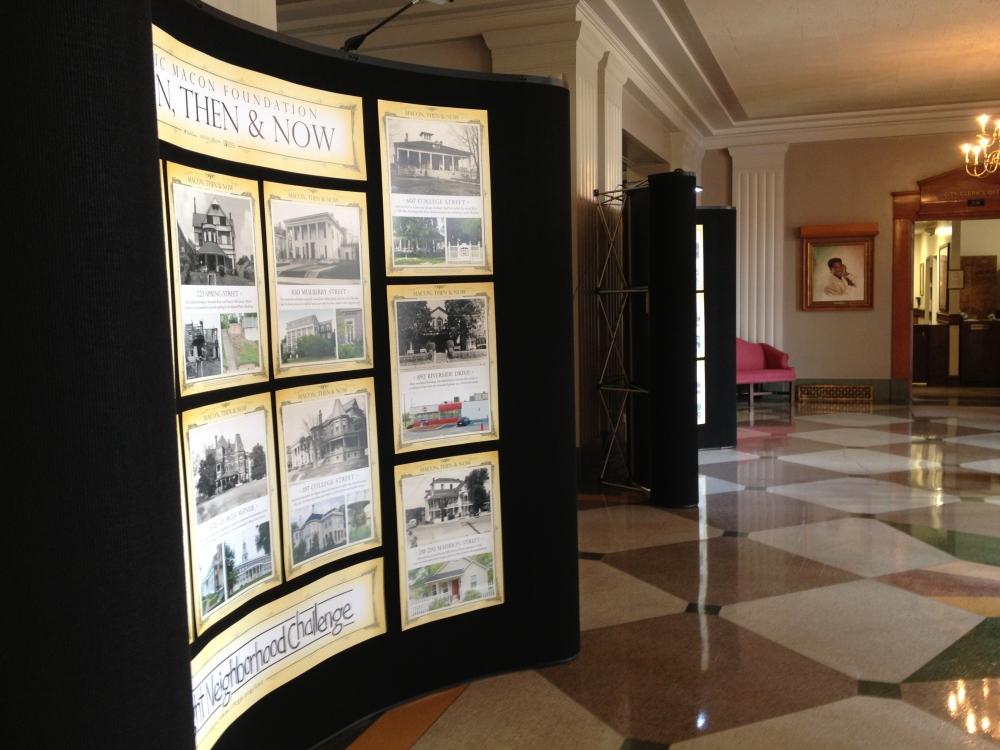
Section Branding
Header Content
Exhibit Shows Macon 'Then And Now'
Primary Content

Macon’s College Hill neighborhood has undergone a rapid transformation in recent years. Investments from neighboring Mercer University and the Knight Foundation have helped revitalize the once dilapidated corridor.
But that’s only the most recent wave of change to sweep over this historic neighborhood. Historic Macon Foundation has commissioned a photo exhibit to tell the story — “Macon Then and Now” is on display in the lobby of City Hall.
'A bronze plaque is not going to work'
Maryel Battin has been working to preserve historic buildings in Macon for over 30 years. You may have seen some of the bronze historical markers she’s helped place on significant public buildings, like Terminal Station.
When Historic Macon asked her to do something similar in College Hill, she realized she would have to change her approach.
"A bronze plaque is not going to work in a residential area because all of the buildings are set back from the street," Battin said. "So that’s how we came up with the idea of a photography exhibit, to be a compliment to what we had done downtown."
Walking into the lobby of city hall, two large black displays line the back wall. A dozen posters are spread out on each. Every poster has a historical photo on top with a view of what is there today on the bottom.
Stark comparisons
Battin said one of the biggest changes you can see starts with a historical photograph of a house on Spring Street. It was the home that well-known Macon architect Alexander Blair designed and built for himself in the late 19th century. "People see it now just as steps going up to a parking area for the Whittle building," Battin said.
Before the house was destroyed, it had a number of strange features. The porch was a weird funnel shape, like a huge lamp shade. "He combined bay windows, tall chimneys, gables, shutters and lots of different textures on the building which is very typical of the Queen Anne period," Battin said.
Some College Hill addresses have undergone even more changes than that.
One of the today photos showed a new pharmacy that just opened at the corner of College Street and Forsyth Street. That’s only the most recent transformation, said Historic Macon executive director Josh Rogers.
"There was this grand Victorian mansion that was made out of brick and it was demolished in 1964 to become a Phillips 66 gas station," Rogers said. "Then just last year, the Phillips 66 gas station which had become abandoned, was demolished and a new pharmacy has taken its place."
This one prominent corner in Macon that thousands of people drive by every day has undergone three huge changes, Rogers said.
Framing the past and present
Volunteers with the Middle Georgia Camera Club took the today shots. One of those volunteers, Alan Thiese, photographed the new pharmacy.
"I tried very hard to get the same vantage point and I think all of us that did this project worked from the archives to get the same view," Thiese said. "In some cases you couldn’t always get the same view because of new stuff developed since then."
Camera Club volunteer Charles Kulpa had trouble figuring out where his address even was. "Somewhere about 20 years ago, when they built another road alongside the house, they decided to renumber the houses based on the other street," Kulpa said.
The house is no longer there. A Krystal restaurant stands in its place at the corner of Spring Street and Riverside Drive, in stark contrast to what was there before.
“Previously it had been a beautiful Victorian house that housed a conservatory for African American music students,” Battin said.
Inspiring conservation
But the photographs don’t just tell sad stories. Some of the houses seen side by side are virtually unchanged. The exhibit is intended to be more than a cautionary tale.
"Our goal is to hopefully get everyone involved in preserving Macon’s historic architecture," Rogers said.
The exhibit will be up in the city hall lobby until the end of June. It will travel around to other locations through the fall.
Tags: historic preservation, Adam Ragusea, Center for Collaborative Journalism, Historic Macon Foundation, Erica O'Neal
